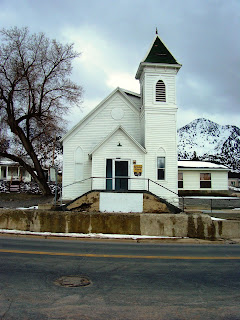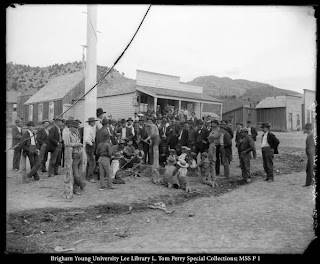I couldn't really figure out where there buildings were located but there is really only a couple of blocks where they could be located, around the western most part of Main St. I decided that the post would work best if split up into two parts (so that's why this is Part 1). Here are the western most buildings:
While walking around this area, I met one of the nicest guys that I have ever met. He owns all of the photos in these buildings and took me on a tour of all of them. He is working to restore all of them, although he is going really slowly (right now he is in the Marshall Islands for the next 6 months). Only one of the buildings, the one of the far right (if I remember right, it is the brick building to the right of the light blue building), even looks partially completed. He would like to open up a restaurant inside; here is a picture of it:
The green building to the right of the light blue building is the McCornick and Company Bank. A plaque on the building reads: "This building was constructed in 1909 to serve as the new home of McCornick and Company bankers and has continued to the present to serve as a bank. McCornick and Company first came to Eureka in 1898, when they moved their bank, fixtures and all, from the mining town of Mercur [located around 15 miles west of Lehi], apparently with the interest of replacing the George Arthur Rice Bank, which had folded in 1897. Around 1917, Eureka Banking Company took over the building, which gave way to the Commercial Service Company in the 1960s. The current occupant of the building is First Security Bank." The plaque was 1985 and contrary to what it says, there is no bank in the building. There was a bank a couple of years ago, but it moved to Goshen and replaced it with an ATM.
I then got an amazing tour of the building that says "The Oxford" and the building next to it (the two are connected inside). Here are some pictures from inside:
There used to be room located behind the wall where the door is. This is where they would hide the alcohol during prohibition days. Just to give you a heads up, pretty much everything that deals with these buildings involves alcohol and prostitutes. Hey, its a mining town, what do you expect?
This is a well inside of the building. The funny thing is that the well has never actually been used for water. The well was used to hide alcohol when the police came looking during prohibition.
After we left this building, I was told that we were going to go to a topless bar. I was really confused (and a little shocked. I knew that topless bars were really common in Oregon, but I hadn't heard of any in Utah). I was taken to the building that is right of the thin building with three windows on the top level (which makes it look like a little Spanish building). Turns out that the bar just doesn't have a roof, which makes it topless. Here are some of the photos from it:
This building has a lot of history to it. It used to be a bar and then a hotel was right above where the miners could go sleep with prostitutes (and that pretty much is the deal with all of the buildings around here). People used to write their names on the boards in the picture above. The oldest one that I found is from 1906, which is right below the 1908 on the top board section. Also there used to be a wall on the right which fell down. It separated the building from a natural water drainage. People would use this little alleyway to sneak into the building, and if nothing else, carve their name in the wood. The building is still being used today for dances, and the guy repairing it hopes to turn it into a dance hall.
I love Eureka. Although all of these shops are run down and closed, I was told that the city comes to life around Spring Break. There is bumper to bumper traffic going through the town trying to get the Little Sahara to go for ATVing at the sand dunes. I hope that some more economy will come to town so that the buildings will stay kept up for good.














































